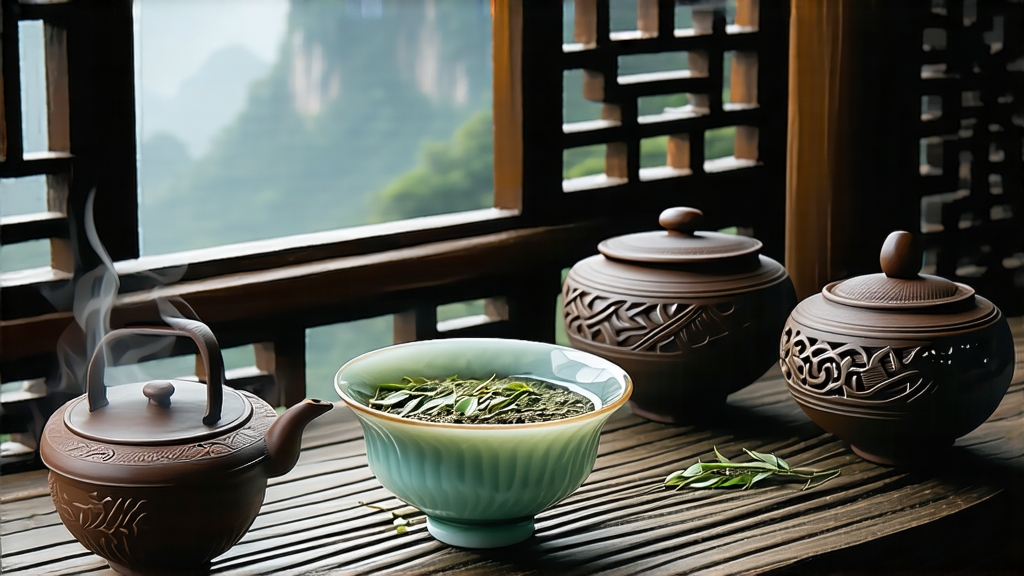
Tucked away in the humid, karst-pocked southwest of China, the small town of Liubao in Guangxi province guards a tea secret that once crossed oceans on clipper ships and perfumed the courts of Qing emperors. Liu Bao—literally “Six Forts”—is the name of the tea, the town, and the memory of a trade route that once began with horse hooves and ended with the clatter of teacups in Jakarta, Singapore, and even London. Today, while Pu-erh hogs the limelight, Liu Bao quietly continues its slow microbial song in dark bamboo baskets stacked in caves, basements, and specially built “fermentation rooms” where time, humidity, and a unique community of molds and yeasts conspire to turn green leaves into velvet darkness.
Historical whispers
The earliest written record appears in the 1860 edition of the Cangwu County Gazetteer: “Tea from Liubao, cool in nature, clears heat and relieves greasiness; merchants buy it in spring and ship it via Guangzhou to foreign lands.” By the late 17th century, Liu Bao was ballasted in the lower holds of Chinese junks sailing for Southeast Asia, where tin miners in Malaya discovered that the tea kept their bodies upright in the oppressive heat and cured the dysentery that stalked the camps. The British noticed, recorded the trade in East India ledgers, and nicknamed it “black betel tea” because its aroma reminded them of the areca nut chewed throughout the archipelago. When the Qing court established the “Tea Tax for the Western Front” in 1757, Liu Bao became one of the five approved border teas, bartered for horses with Tibetan and Mongolian traders, embedding itself into the ethnic memory of high-altitude yak-butter brews.
Varietal identity
Camellia sinensis var. sinensis, the small-leaf China plant, is the botanical starting point, but terroir twists the genetics into something unmistakable. Liubao sits at 23° north, 200–500 m above sea level, where the Qinling range’s tail dissolves into subtropical jungle. Granite soils, year-round fog, and diurnal swings load the leaves with aromatic amino acids and a low bitterness index. Locals divide the harvest into three grades—“teji” (special), “yiji” (first), and “erji” (second)—but connoisseurs speak in seasonal code: “chunjian” (spring tips) for perfume, “gujian” (autumn tips) for throat-sweetness, and “yujian” (rainy-season tips) for budget, everyday brews. Old-garden bushes, some 80–100 years old, rise on terraced hillsides interplanted with cinnamon and mandarin trees whose roots share mycorrhizal networks, adding a whisper of spice that later emerges in the cup as “guiwei” (cinnamon rhyme).
Crafting darkness: from sun-wither to wet pile
Picking begins at dawn when the dew still weighs down the apical bud and first two leaves. After a brief outdoor withering to shed surface moisture, the leaves are sent to a heated wok kept at 280 °C where they are tossed by hand for exactly three minutes; the goal is to arrest oxidation while leaving the stem core alive. A short rolling—no more than ten minutes on a bamboo tray—breaks cell walls and extricates the juice that will feed future microbes. The twist comes next: instead of being dried immediately, the leaves are heaped 30 cm deep on bamboo mats and left to “duiwei” (stack-ferment) for 8–12 hours. During this self-heating phase, temperatures rise to 45 °C, triggering non-enzymatic browning and the first kiss of indigenous yeasts.
The real transformation, however, happens in the “wet pile” room, a technique that predates Pu-erh’s wòduī by at least a century. Workers spray 70 °C river water—rich in local minerals—onto the leaf piles until moisture reaches 35 %. The heap is then covered with jute sacks and left for 25–35 days, turned twice weekly to aerate. Humidity hovers at 85 %, inviting a golden bloom of Eurotium cristatum, the same “golden flower” prized in Hunan Fu brick